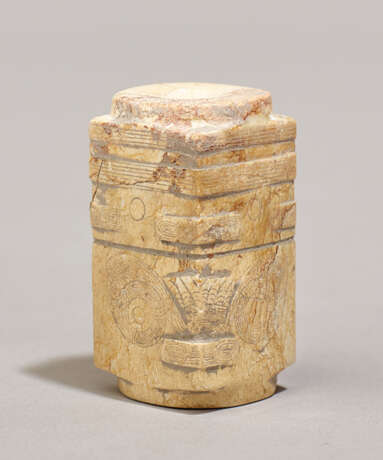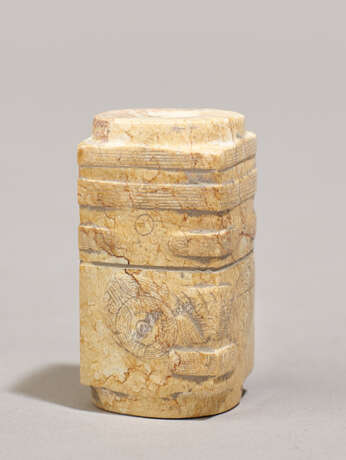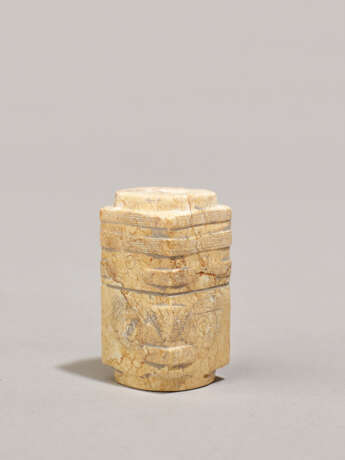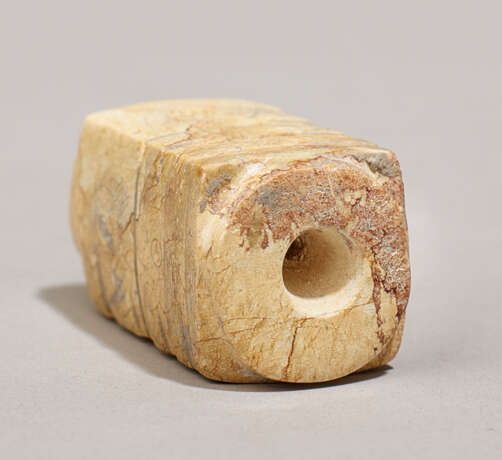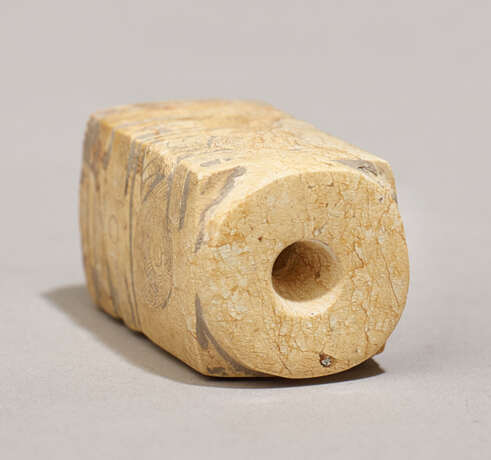A CONG-SHAPED BEAD IN WHITENED JADE WITH RUSSET VEINS DECORATED WITH FINELY RENDERED MASKS
29.09.2017 16:00UTC +01:00
Classic
Prix de départ
1800EUR € 1 800
| Auctioneer | Galerie Zacke |
|---|---|
| Lieu de l'événement | Autriche, Wien |
| Commission | 27.000% |
Archive
La vente aux enchères est terminée. Vous ne pouvez plus enchérir.

ID 7345
Lot 7 | A CONG-SHAPED BEAD IN WHITENED JADE WITH RUSSET VEINS DECORATED WITH FINELY RENDERED MASKS
Valeur estimée
€ 3 600
獸面紋琮形玉墜 - 新石器時代晚期, 良渚文化, 約公元前3300-2200年
HEIGHT: 4.8 CM, WIDTH: 2.6 CM
高4.8厘米,寬2.6厘米
Although most Liangzhu beads are cylindrical or spherical and bear no decoration, this one belongs to the category of beads with a square cross-section worked in the shape of a miniature cong 琮. The bead is decorated with the two types of masks that are seen on Liangzhu culture jades. The masks are accurately rendered and organized in two registers, with the anthropomorphic mask placed over the animal one. Given the reduced space on which the images are carved, the round eyes of the human-like mask are set at the centre of the four sides, so that they are shared by each of the masks carved at the corners. Instead, the zoomorphic masks are fully detailed, but there are only two of them since each one occupies two sides of the bead. The parallel, striated bands on the top border form a continuous band.
The jade has turned almost opaque white, while the surface is covered by reddish lines, indicating the presence of oxidized iron in the stone. This alteration, artificially induced through ritual burning of the jades at the time of burial, is also seen on Liangzhu jades that were excavated from the two elite cemeteries of Fanshan and Yaoshan in Yuhan county, Zhejiang.
Although small cong-shaped beads like this one may have been strung together with several others to compose elaborate necklaces that were reserved for the members of the Liangzhu aristocracy, archaeological evidence indicates that they might also have been used to decorate ritual jade axes: the beads were probably hung by small ropes that were secured onto the wooden shaft, whose extremities were also occasionally adorned with jade fittings.
Literature comparison/Archaeological sites: These beads can be compared to similar ones excavated from Liangzhu culture sites, such as those reproduced in Zhejiang Institute of Cultural Relics and Archaeology 浙江省文物考古研究所, Liangzhu wenhua yuqi 良渚文化玉器 (Jades of the Liangzhu Culture), Wenwu chubanshe, Beijing 1990, nos.70, 175-177, and in Huang Xuanpei, Gems of the Liangzhu Culture from the Shanghai Museum, Hong Kong Museum of History, Hong Kong 1992, no.69. This bead can also be compared to three similar ones published in F. Salviati, 4000 Years of Chinese Archaic Jades, Vienna 2017, no.68.
Expertise: Prof. Dr. Filippo Salviati
From an Austrian collection
奧地利老佔有
All jades in this catalogue have been professionally examined, authenticated and described by Prof. Fillipo Salviati. Professor Salviati teaches Chinese and Korean art at Sapienza University in Rome, in the Italian Institute of Oriental Studies. He is a world expert on archaic Chinese jades, having released multiple publications and being cited by renowned auction houses such as Sotheby’s.
| Adresse de l'enchère |
Galerie Zacke Mariahilferstrasse 112 1070 Wien Autriche | ||||||||||||||
|---|---|---|---|---|---|---|---|---|---|---|---|---|---|---|---|
| Aperçu |
| ||||||||||||||
| Téléphone | +00 4315-320 452 | ||||||||||||||
| Fax | +43-1-5320452-20 | ||||||||||||||
| Commission | 27.000 | ||||||||||||||
| Conditions d'utilisation | Conditions d'utilisation | ||||||||||||||
| Heures d'ouverture | Heures d'ouverture
|
